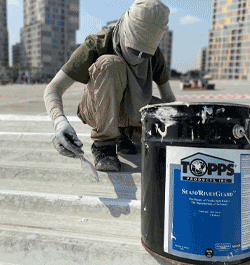UP TO THE MINUTE
Best practices for quality control with liquid-applied roofing systems

CCS Influencer John Kenney says implementing best practices for quality control in liquid-applied roofing systems is essential for ensuring their durability, performance and customer satisfaction.
Liquid-applied roofing systems have gained popularity in the industry due to their flexibility, seamless application and durability. However, stringent quality control measures must be in place to ensure these systems deliver their maximum potential. Quality control guarantees the roofing system's performance and longevity, minimizes costly repairs and ensures customer satisfaction. Here are some best practices for maintaining high-quality control standards with liquid-applied roofing systems.
Pre-application preparations
Thorough inspection and surface preparation: Before applying any liquid-applied roofing system, it is crucial to conduct a detailed inspection of the substrate. This includes checking for any defects, debris or moisture affecting adhesion. Cleaning the surface thoroughly and ensuring it is dry is essential. Any existing loose or damaged roofing material must be repaired or removed. Proper surface preparation sets the foundation for a successful application and ensures that the liquid membrane adheres appropriately.
Moisture testing: Moisture can significantly impact the performance of a liquid-applied roofing system. Conducting moisture tests on the substrate ensures no underlying issues could lead to adhesion problems or future water damage. Using moisture meters or conducting core samples can help identify any hidden moisture within the substrate.
Material selection and handling
Choosing the right product: The appropriate liquid-applied roofing product for the specific application is vital. Different products are formulated for various substrates and environmental conditions. Consulting with manufacturers and understanding the product specifications will ensure you choose a system that meets the project's requirements.
Proper storage and handling of materials: Liquid-applied roofing materials must be stored and handled according to the manufacturer's guidelines. This includes maintaining the correct temperature and avoiding exposure to direct sunlight or extreme weather conditions. Proper storage prevents premature curing or degradation of the materials, ensuring optimal application performance.
Application techniques
Following manufacturer's instructions: Adhering strictly to the manufacturer's application guidelines is crucial. This includes mixing ratios, application thickness and curing times. Deviating from these instructions can compromise the roofing system's integrity and lead to failures.
Using the right tools and equipment: Applying liquid-applied roofing systems requires specific tools and equipment. Ensure that all applicators are trained in using the right tools, such as brushes, rollers or spray equipment. Proper tool selection and maintenance are essential for achieving a consistent and even application.
Monitoring weather conditions: Weather conditions play a significant role in applying and curing liquid-applied roofing systems. Monitoring the weather forecast and avoiding application during rain, high humidity or extreme temperatures is important. Adverse weather conditions can affect the roofing system's curing process and overall performance.
Quality assurance during application
Regular inspection and testing: Continuous inspection and testing during the application process are vital for quality control. This includes checking the thickness of the applied material using a wet film thickness gauge and ensuring uniform coverage. Conducting adhesion tests on a small area can also verify that the material is bonding correctly to the substrate.
Documentation and record-keeping: Maintaining detailed records of the application process, including the materials used, weather conditions and inspection results, is crucial. This documentation provides a reference for future maintenance and can be useful in case of any disputes or warranty claims.
Post-application practices
Allowing adequate curing time: Ensuring the liquid-applied roofing system has sufficient time to cure is essential for its performance. Avoid foot traffic or placing equipment on the roof until the material is fully cured. Curing times can vary based on the product and environmental conditions, so always refer to the manufacturer's guidelines.
Final inspection and testing: Conduct a thorough final inspection once the application is complete and the material has cured. This includes checking for any missed areas, pinholes or inconsistencies in the application.
Ongoing maintenance and inspections
Regular maintenance: Implementing a regular maintenance schedule is key to prolonging the life of the liquid-applied roofing system. Regular inspections and prompt repairs of any damage or wear can prevent minor issues from becoming major problems.
Training and certification: Ensuring that your team is trained and, where possible, certified in the application of liquid-applied roofing systems can significantly improve the quality of installations. Ongoing training keeps your team updated on the latest techniques and products.
Implementing best practices for quality control in liquid-applied roofing systems is essential for ensuring their durability, performance and customer satisfaction. Every step plays a critical role in achieving high-quality results, from thorough pre-application preparations and proper material handling to meticulous application techniques and ongoing maintenance. By adhering to these best practices, roofing companies can deliver reliable and long-lasting roofing solutions that meet the highest standards of excellence.
John Kenney is the CEO of Cotney Consulting Group. See his full bio here.


















Comments
Leave a Reply
Have an account? Login to leave a comment!
Sign In